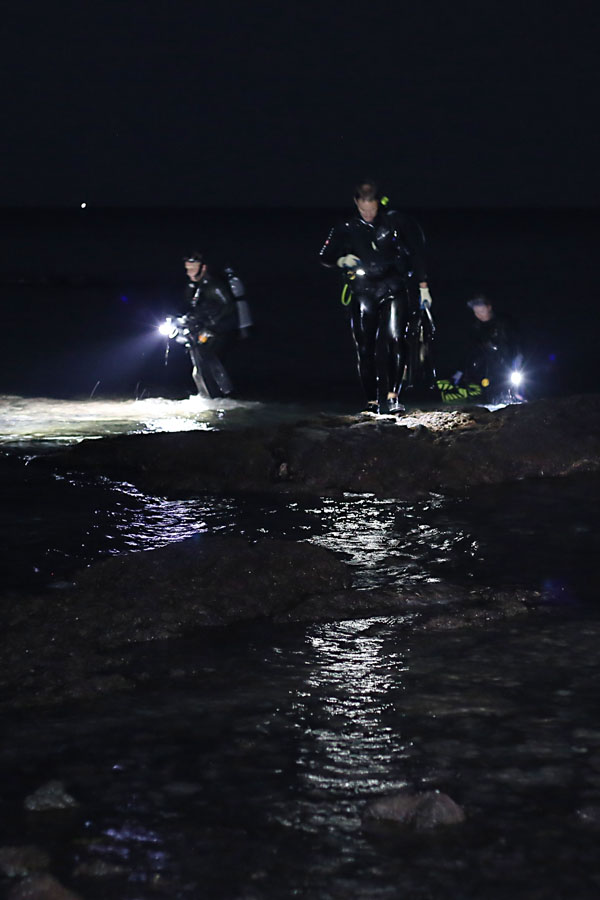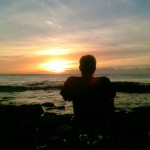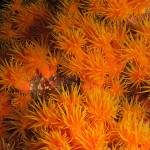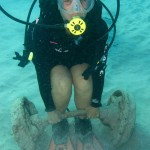
Tag: night dive
Night Diving under a Supermoon
The term supermoon may be a bit of over-the-top hype, it was still nice to dive under the light of a bright full moon. The plan is simple, meet at 4pm for a late afternoon dive, followed by a night dive. Gear and dinner loaded we quickly slip the lines and head out in a smoothly practiced routine. Where is the boat going, I really do not care, wherever we dive it is going to be good.

I love the late afternoon light on the reef. As the light dims the shades become more blue. The lower intensity allows me to control the light better, the strobe overpowering the ambient light on the target of interest. The background becomes an attractive blue, open water photos loose the odd green cast that is difficult or impossible to fix in Photoshop. The fish are less flighty as well, beginning to shift from daytime routine to finding a place in the coral for the night.
Puakō Night Dive
Watching sunset is one way to end the day, in this case it heralded the start of our activity. We were waiting for the Sun to go away, for the skies to grow dark. We were preparing for a night dive.
Once again into the black water, looking to meet the the reef’s night shift. It would be our usual crew… Pete, Sky, Mark and myself for the dive. Dennis joined for dinner, but did not stay for the dive.

While I had never used this particular entry, we were all familiar with the Puakō reef, having dove the area many times over the years. The layout is pretty straightforward. A shallow reef slopes away from shore for about 50-100yards, reaching about 10ft deep. There you will find ancient sea cliffs, a sheer rock wall that drops to 25′ or 35′ depth. Below this wall the reef slopes away, sometimes gently, sometimes steeply. At 70-100ft you reach sand that slopes further into the abyss. Our goal would be the old cliffs. These are pockmarked with small caves and overhangs, excellent terrain to explore on a night dive, there should be plenty of small invertebrates about.
The plan was simple, taking advantage to the nature of the Puakō reef and the multiple entries available along the shoreline. We would enter at one point, do a one way dive along the submerged seacliffs at 20-30ft, then exit at another entry about a quarter mile further south. Exit would be aided by a strobe left at the designated exit point, a bright light in flash mode easily visible to lead us back to the correct landfall.
Overhead a full Moon rose, lighting the sky and aiding our visibility. Once under water the moonlight would ad another dimension to the dive. The glow of moonlight coming through the water was sometimes quite pretty.
At one point I did something I almost never do on a Hawaiian reef. I was actually forced to use my compass for navigation. Normally the slope of the reef quickly indicates which way is shore. I had followed Mark out onto the reef below the wall. After a little photography I found myself disoriented, which was was the shore? I held my compass to the divelight to charge the glow-in-the-dark dial, then got my bearings to head back to the wall. I know I bought the console with a compass for some reason. Just a reminder of how easy it is to lose ones bearings in the dark water.

The strobe worked very well, we were able to head inshore, across the reef shallows, to just the right point. The shallows at Puakō can be a nuisance to cross in the day, they are more so at night. There was no real surf to complicate the issue, but you are just feeling your way across the rocks. I only put my hand on one urchin.
It was a pretty stroll back to the house along Puakō Road. A warm tropical night, a bright full Moon high overhead. We were chatting about the dive, reveling in the experience. One car did pass us as we walked, it must have been an interesting sight… A group of four guys in full scuba gear, dripping wet, walking down the center of the road.
Back at Pete’s place we broke out snacks and drinks. Beer and scotch appeared, dive photos reviewed, as we talked story for hours. Yeah, it was that sort of night.
Night Dive at Mahukona
The plan… Arrive at Mahukona in the mid-afternoon, do an afternoon dive. Then we fire up a barbeque and have dinner, talk story and watch sunset from a beautiful Hawaiian shore. When it gets dark we load up a second tank and head back out for a night dive. Not a bad plan! I have not been night diving in quite a while, so when the plan was suggested I readily agreed.
Our group contained several folks who had never dove Mahukona. Thus the afternoon dive plan was obvious, head for what remains of the SS Kauai, visiting the engine and propeller, exploring scraps of the cargo. From there we headed out onto the coral beyond, exploring the reef due west of the engine to a depth of about fifty feet. It was a nice afternoon dive, nothing particularly exciting found. I noted the behavior change in many fish, seen as the light begins to fade. While not yet dark, it was apparent that the fish were readying for night, hovering close to chosen coral heads, awaiting the coming darkness.

